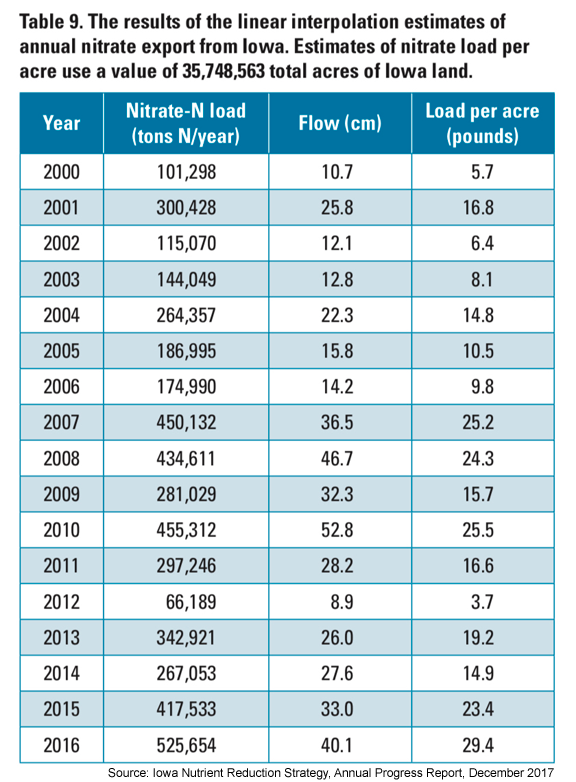by Jared Strong, Iowa Capital Dispatch
March 27, 2024
A fertilizer spill this month in southwest Iowa killed nearly all the fish in a 60-mile stretch of river with an estimated death toll of more than 750,000, according to Iowa and... more
An estimated 526,000 tons of nitrates were "exported" into Iowa rivers and streams in 2016, eventually flowing down the Mississippi River to the Gulf of Mexico and adding to the so-called "dead zone" where fish cannot survive.
According to the Annual Progress Report of the Iowa Nutrient Reduction Strategy (NRS) group released last week (12/12), more than 29 pounds of nitrogen from each of Iowa's 35.75 million acres of crop land ended up in state waterways.
Ag runoff (non-point sources) is responsible for more than 90 percent of all nitrogen pollution and more than 64 percent of all phosphorus runoff in Iowa streams, lakes and rivers. The remainder comes from "point sources," primarily municipal wastewater treatment plants and industrial facilities.

The goal of the NRS is to reduce Iowa's nitrogen and phosphorus runoff by 45 percent – some 138,000 tons of nitrogen and 7,600 tons of phosphorus. The reduction target is based on the average of 307,000 tons of nitrogen and 16,800 tons of phosphorus estimated to have been deposited in state waterways annually during the period 2006 through 2010.
Thanks to an ever-increasing number of water monitors on large and small Iowa watersheds, researchers are now able to better determine the amount of nitrogen and phosphorus runoff from non-point sources, and will eventually be able to map and analyze how effective various conservation methods like terraces, bioreactors, cover crops and buffer strips are at reducing chemical runoff from state watersheds.
The U.S. Geological Survey (USGS), the Iowa Department of Natural Resources (IDNR) and the University of Iowa's Hydroscience & Engineering (IIHR) research institute have in place a network of water monitors statewide on small- and medium-sized watersheds of up to 1,000 square miles.
"These sensors measure nitrogen (nitrate and nitrite), flow, along with other site-specific parameters which may include pH, dissolved oxygen, temperature, and discharge, depending on the site," according to the NRS report.
"There are currently about 27 sites with sensors that monitor the outlets of watersheds that are less than 100 square miles in size," the report states. "These sensors may provide information for land use and land management of these practices' impacts on the concentration of pollutants immediately downstream. . ."
There are 46 sites monitoring nitrogen, flow and other parameters at the outlets of watersheds from 100 to 1,000 acres in size, and another 34 monitoring sites of very large watersheds of more than 1,000 square miles.
"These sites (of very large watersheds) provide the basis for statewide estimates of nitrogen export, as at least 88 percent of Iowa's land drains to monitored locations, allowing for tracking of the vast majority of Iowa's surface water," according to the report.
The Iowa Soybean Association also has been expanding its water monitoring network at individual members/farms from 10 sites in 2014 to 374 sites in 2017.
The specific data is confidential, but some "key findings" from 2016, according to the NRS report, included:
• Average concentration levels of nitrate in water flowing from the field tiles (underground pipes which drain excess water from fields) was highest in the Des Moines Lobe landform (flowing into the North Raccoon River watershed) at 16.3 milligrams per liter. The lowest concentration was 10.1 milligrams per liter from field tiles draining into the Southern Iowa Drift Plain (covering most of the southern half of the state).
• The average nitrate level from corn field tile drains was 16 milligrams per liter, compared with soybean field drain tile concentrations of 12.9 milligrams per liter.
• The highest nitrate concentrations and loads occurred in May and June.
• Fields which used cover crops (usually planted in the fall) had nitrate concentrations 29 percent lower than fields not using cover crops.
The draining of farm fields with underground tiles was the subject of a controversial lawsuit by the Des Moines Water Works against 10 North Central Iowa drainage districts. The water treatment plant has added costly filtering systems to reduce the amount of nitrate in water to meet federal drinking water standards.
The suit sought financial damages from the drainage districts and to have the courts classify the drainage districts as point source pollution sources subject to the same state and federal water quality regulations as industrial and municipal waste water plants. The case was dismissed in federal court which ruled drainage districts did not have the power to address the nitrate issue.
CLICK HERE to download the full Nutrient Reduction Strategy report.
by Jared Strong, Iowa Capital Dispatch
March 27, 2024
A fertilizer spill this month in southwest Iowa killed nearly all the fish in a 60-mile stretch of river with an estimated death toll of more than 750,000, according to Iowa and... more
by Robin Opsahl, Iowa Capital Dispatch
March 25, 2024
The Iowa Senate on Monday sent a bill to the governor’s desk restricting stormwater and topsoil regulations, a measure Democrats say unfairly limits local control.
The Senate... more
Iowa Capital Dispatch
March 11, 2024
The Iowa House passed legislation Monday on local storm water and top soil regulation after the same bill failed last week.
... more
An India online media company, Quint Digital Limited of Delhi, has purchased a 10 percent stake in Lee Enterprises, Inc., owner of the Quad City Times, the Dispatch/Argus and more than 70 other media properties.
Quint Digital and three of its owners, Raghav Bahl, Ritu Kapur and Vidar Bahl... more
Powered by Drupal | Skifi theme by Worthapost | Customized by GAH, Inc.

